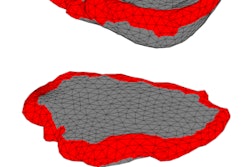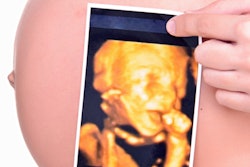
3D power Doppler can help confirm fetal growth restriction (FGR), a pathologic condition that occurs in up to 9% of pregnancies and can affect not only how a woman's pregnancy is followed but also when she delivers her baby, according to a study published in the January issue of the Journal of Ultrasound in Medicine.
FGR is identified by assessing blood flow to the brain, which tends to be redistributed in a "brain-sparing" response to chronic hypoxia in fetuses with the condition, wrote a team led by Dr. Katherine Goetzinger from the University of Maryland School of Medicine. The current clinical standard to diagnose FGR, 2D pulsed Doppler ultrasound, is used to evaluate the middle cerebral artery. But it has limitations, including an inability to detect changes in blood flow in small vessels.
3D power Doppler technology may be a more effective tool.
"An advantage of 3D power Doppler ultrasound over conventional 2D pulsed Doppler ultrasound is its ability to evaluate an entire region of perfusion as opposed to flow within a single vessel," the authors wrote. "In addition, 3D power Doppler ultrasound is more sensitive in detecting low-velocity blood flow in small, low-resistance vessels such as those in the fetal brain."
Difficult to discern
Fetal growth restriction is a major contributor to perinatal morbidity and mortality, according to the study authors. However, even though it is suspected in all fetuses who have an ultrasound-estimated weight below the 10th percentile, it can be difficult to discern whether the fetuses are constitutionally small or whether they have a pathologic condition (J Ultrasound Med, January 2018, Vol. 37:1, pp. 139-147).
The advent of 3D power Doppler technology has given clinicians the ability to quantify blood flow in fetal organs such as the kidney, liver, and placenta by evaluating both vascularization and flow indexes. Goetzinger's group sought to explore whether the technology could also be used to assess blood flow in fetuses with FGR.
The study included 306 women pregnant with a single fetus who presented for growth ultrasound exams between 24 and 36 weeks of gestation between 2011 and 2013. Women with fetuses with FGR were matched with those with fetuses at an appropriate weight for their gestational age (AGA). The researchers used the 2D Doppler parameters of vascularization index, flow index, and vascularization-flow index to assess 3D power Doppler ultrasound findings in fetuses with and without FGR.
Of the 306 patients, 151 had fetuses with an estimated weight less than the 10th percentile; these were compared with 155 controls. On average, women with FGR fetuses were significantly younger and had lower body mass indexes than their control counterparts; however, there was no significant difference in race, tobacco or alcohol use, chronic hypertension, and pregestational diabetes between the two groups.
When the researchers compared the 3D power Doppler indexes among the two groups, they found no significant difference in the vascularization index or vascularization-flow index, but they did find that the flow index was significantly higher in the FGR fetuses.
| 3D vascular indexes for fetal growth restriction | |||
| Parameter | FGR fetuses (n = 151) | AGA fetuses (n = 155) | p-value |
| Flow index | 33.9 | 32.3 | 0.009 |
| Vascularization index | 6 | 5.7 | 0.65 |
| Vascularization-flow index | 2 | 1.8 | 0.31 |
"This finding suggests that changes in the flow index may be more subtle signs of brain blood flow redistribution, which may be evident before changes in conventional 2D pulsed-wave Doppler measurements of the middle cerebral artery are measurable," Goetzinger and colleagues noted.
Novel application
3D power Doppler quantification of cerebral blood flow is significantly altered in fetuses with FGR compared to those at appropriate gestational weight, and it may be a more sensitive marker of blood flow than 2D middle cerebral artery pulsed Doppler findings, the group concluded.
"The novel application of this technique in the assessment of FGR may have the potential to identify fetuses with brain-sparing pathophysiologic states earlier in the course of gestation, which could have implications for fetal surveillance strategies and the timing of delivery," the researchers concluded.




















